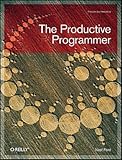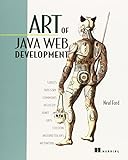Neal Ford
Director / Software Architect / Meme Wrangler
Neal is Director, Software Architect, and Meme Wrangler at ThoughtWorks, a global IT consultancy with an exclusive focus on end-to-end software development and delivery.Before joining ThoughtWorks, Neal was the Chief Technology Officer at The DSW Group, Ltd., a nationally recognized training and development firm. Neal has a degree in Computer Science from Georgia State University specializing in languages and compilers and a minor in mathematics specializing in statistical analysis.
He is also the designer and developer of applications, instructional materials, magazine articles, video presentations, and author of 6 books, including the most recent The Productive Programmer. His language proficiencies include Java, C#/.NET, Ruby, Groovy, functional languages, Scheme, Object Pascal, C++, and C. His primary consulting focus is the design and construction of large-scale enterprise applications. Neal has taught on-site classes nationally and internationally to all phases of the military and to many Fortune 500 companies. He is also an internationally acclaimed speaker, having spoken at over 100 developer conferences worldwide, delivering more than 600 talks. If you have an insatiable curiosity about Neal, visit his web site at http://www.nealford.com. He welcomes feedback and can be reached at nford@thoughtworks.com.
Presentations
Agile.next
8:30 AM MDT
Agile has matured to the point of mainstream success. Even large companies have discovered that it helps them build better quality software faster. But the agile practices that are mainstream today have been around for a long time. What is the next wave of innovation in the Agile world going to bring?
Agile software development works because of feedback loops, and to
make it better (or repair what's broken), you identify missing
feedback loops, or replace broken ones. This talk uncovers two
feedback loops missing from most projects. The first uses Behavior
Driven Development & Cucumber to incorporate business
analysts, testers, subject matter experts, and developers one one
platform for requirements definition and verification. The other
anemic feedback loop in many organizations involves the last mile to
production: you have error prone, horrific manual releases that
everyone hates. Continuous Delivery delivers proven techniques
and tools to make “Done” better.
Emergent Design
10:30 AM MDT
Emergent design is a big topic in the agile architecture and design community. This session covers the theory behind emergent design and shows examples of how you can implement this important concept.
This session describes the current thinking about emergent design, discovering design in code. The hazard of Big Design Up Front in software is that you don't yet know what you don't know, and design decisions made too early are just speculations without facts. Emergent design techniques allow you to wait until the last responsible moment to make design decisions. This talk covers four areas: emergent design enablers, battling things that make emergent design hard, finding idiomatic patterns, and how to leverage the patterns you find. It includes both proactive (test-driven development) and reactive (refactoring, metrics, visualizations, tests) approaches to discovering design, and discusses the use of custom attributes, DSLs, and other techniques for utilizing them. The goal of this talk is to provide nomenclature, strategies, and techniques for allowing design to emerge from projects as they proceed, keeping you code in sync with the problem domain. This talk shows lots of examples of how to make this concept work in your environment.
Functional Thinking in Java 8, Clojure, Groovy, and Scala
3:15 PM MDT
Learning the syntax of a new language is easy, but learning to think under a different paradigm is hard.
Learning the syntax of a new language is easy, but learning
to think under a different paradigm is hard. This session
helps you transition from a Java writing imperative programmer to a
functional programmer, using Java, Clojure and Scala for
examples. This session takes common
topics from imperative languages and looks at alternative ways of
solving those problems in functional languages. As a Java developer, you know how to achieve code-reuse
via mechanisms like inheritance and polymorphism. Code reuse is
possible in functional languages as well, using high-order
functions, composition, and multi-methods. I show examples from my book Functional Thinking of shifting your perspective on problems, ceding messy details to the language, working smarter, not harder, and how to deal with multiparadigm languages.
Agile Engineering Practices
5:00 PM MDT
Most of the time when people talk about agile software development, they talk about project and planning practices and never mention actual development practices. This talk delves into best development practices for agile projects, covering all of its aspects.
Most of the time when people talk about agile software development, they talk about project and planning practices but never mention actual development, as if development where an afterthought when writing software. This talk bills into the real details of how to do agile development. I discuss best practices like continuous integration, pair programming, how developers should interact with story cards, how to handle enterprise concerns like integration with other software packages, and a slew of other topics related to agile software development.
Build Your Own Technology Radar Workshop for Architects
8:30 PM MDT
A Technology Radar is a tool that forces you to organize and think about near term future technology decisions, both for you and your company. This talk discusses using the radar for personal breadth development, architectural guidance, and governance.
ThoughtWorks Technical Advisory Board creates a “technology radar” twice a year, a working document that helps the company make decisions about interesting technologies and where we spend our time. ThoughtWorks then started conducting radar-building exercises for our clients, which provides a great medium for technologists company-wide to express their opinions about the technologies they use every day. For companies, creating a radar helps you document your technology decisions in a standard format, evaluate technology decisions in an actionable way, and create cross-silo discussions about suitable technology choices. This session describes the radar visualization and how to conduct a radar building session for yourself. After a brief introduction, the bulk of the workshop consists of attendees building a radar for the group, following the same procedure you'll use when you do this exercise at your company. At the end, we'll have created a unique Radar for this event and practiced doing it for yourself.
JRuby in Depth
9:00 AM MDT
Like hamburger & fries and turkey & dressing, JRuby allows you to harness the awesome power of Ruby in your Java projects. This workshop describes the origins, capabilities, and limitations of JRuby, the 100% pure-Java implementation of the Ruby programming language. This workshop also demonstrates some areas where it makes sense to mixin Ruby and Java code: building swing applications, testing, and dynamic programming.
This workshop includes tons of examples, including side-by-side comparisons of Java and equivalent JRuby code. It also covers some more advanced topics like building domain specific languages, meta-programming (including real uses!), and more.
JRuby in Depth
11:00 AM MDT
Like hamburger & fries and turkey & dressing, JRuby allows you to harness the awesome power of Ruby in your Java projects. This workshop describes the origins, capabilities, and limitations of JRuby, the 100% pure-Java implementation of the Ruby programming language. This workshop also demonstrates some areas where it makes sense to mixin Ruby and Java code: building swing applications, testing, and dynamic programming.
This workshop includes tons of examples, including side-by-side comparisons of Java and equivalent JRuby code. It also covers some more advanced topics like building domain specific languages, meta-programming (including real uses!), and more.
4 Practical Uses for Domain Specific Languages
3:15 PM MDT
Domain Specific Langauges seems like a cool idea, but where's the payoff? This talk provides an overview of how to build both internal and external DSLs (including the state of the art tools), stopping along the way to show how this is practical to your day job.
This talk defines of DSLs (Domain Specific Languages), distinguishes the types of DSLS (internal and external), and shows examples of building DSLs of several kinds. It shows how to utilize DSLs for externalizing configuration (which you're already doing, whether you realize it or not), how to make your code readable to humans, how DSLs make developer tools better (and how to use DSL techniques to build your own tools), and how DSLs can provide your users unprecedented flexibility and power, by building DSLs customized to their job. This talk provides a good foundation for the subject if you've never seen anything about it, but keeps the focus on practical goals.
Books
The Productive Programmer (Theory in Practice (O'Reilly))
by Neal Ford
Anyone who develops software for a living needs a proven way to produce it better, faster, and cheaper. The Productive Programmer offers critical timesaving and productivity tools that you can adopt right away, no matter what platform you use. Master developer Neal Ford not only offers advice on the mechanics of productivity--how to work smarter, spurn interruptions, get the most out your computer, and avoid repetition--he also details valuable practices that will help you elude common traps, improve your code, and become more valuable to your team. You'll learn to:- Write the test before you write the code
- Manage the lifecycle of your objects fastidiously
- Build only what you need now, not what you might need later
- Apply ancient philosophies to software development
- Question authority, rather than blindly adhere to standards
- Make hard things easier and impossible things possible through meta-programming
- Be sure all code within a method is at the same level of abstraction
- Pick the right editor and assemble the best tools for the job
This isn't theory, but the fruits of Ford's real-world experience as an Application Architect at the global IT consultancy ThoughtWorks. Whether you're a beginner or a pro with years of experience, you'll improve your work and your career with the simple and straightforward principles in The Productive Programmer.
The ThoughtWorks Anthology: Essays on Software Technology and Innovation (Pragmatic Programmers)
by ThoughtWorks Inc.
ThoughtWorks is a well-known global consulting firm; ThoughtWorkers are leaders in areas of design, architecture, SOA, testing, and agile methodologies. This collection of essays brings together contributions from well-known ThoughtWorkers such as Martin Fowler, along with other authors you may not know yet. While ThoughtWorks is perhaps best known for their work in the Agile community, this anthology confronts issues throughout the software development life cycle. From technology issues that transcend methodology, to issues of realizing business value from applications, you'll find it here.
No Fluff, Just Stuff Anthology: The 2006 Edition (Pragmatic Programmers)
by
Twenty-seven weekends a year, the No Fluff, Just Stuff conference rolls into another town, featuring the world's best technical speakers and writers. Up until now, you had to go to one of the shows to soak up their collective wisdom. Now, you can hold it in the palm of your hand. The No Fluff, Just Stuff Anthology represents topics presented on the tour, written by the speakers who created it. This book allows the authors the chance to go more in depth on the subjects for which they are passionate. It is guaranteed to surprise, enlighten, and broaden your understanding of the technical world in which you live.
The No Fluff, Just Stuff Symposium Series is a traveling conference series for software developers visiting 27 cities a year. No Fluff has put on over 75 symposia throughout the U.S. and Canada, with more than 12,000 attendees so far. Its success has been a result of focusing on high quality technical presentations, great speakers, and no marketing hype. Now this world-class material is available to you in print for the first time.




